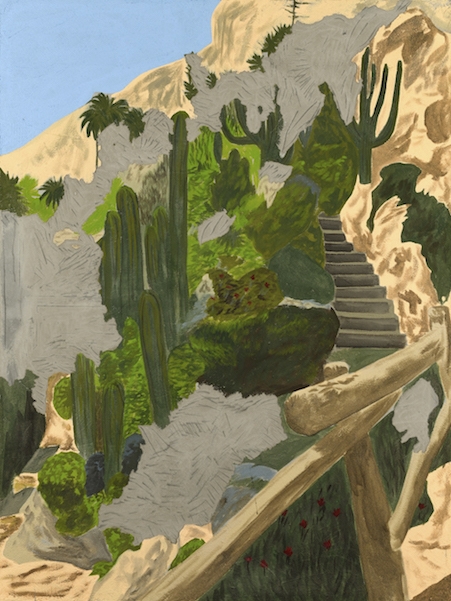At Villa Sauber, one of two venues of Monaco’s national museum, Latifa Echakhch taps into the principality’s history and image as a romantic and exotic place, simultaneously indulging in a form of nostalgia for Monaco’s belle époque while poetically revealing the place’s constructed, artificial nature. The villa – one of the last remaining shrines to Monaco’s architectural golden age of the early 1900s, now virtually vanished amid the ever-more-dense urban landscape of the Larvotto district – and the museum’s collection prove to be essential sources of inspiration for this show. For it, the Moroccan-French artist has transformed two floors of the villa’s galleries into theatre sets, featuring scenography representing romantic landscapes, fragments of nature and classical ruins, painted on cutout plywood boards. Taking inspiration from details of sets by Alphonse Visconti, designer at the Opéra de Monte-Carlo between 1903 and 1938, these decors are unpopulated, seemingly waiting for us to inhabit them and, moving through them, go beyond the illusion to confront the boards’ blank black backs.
Given the exhibition’s title, one might expect these static landscapes to move mechanically on- and offstage, yet the machine-driven component of Echakhch’s ‘garden’ actually resides in the accompanying videos in each room. Drawing on the museum’s iconic collection of nineteenth-century automata (which, donated by French collector Madame de Galéa in 1972, prompted the creation of the institution itself), these short videos each star one of said automata performing alongside its electric replica (these were created during the late twentieth century for conservation purposes). They are intimate portraits of these mechanical chefs-d’oeuvre and their doubles as they perform their usual routines, shot in closeup and from varying angles to reinforce the illusionistic performance: we peek over Pierrot’s shoulder as he writes a letter to his dear Columbine, or spy from the side the illusionist in action, becoming accomplices to his tricks.
Two of the automata filmed by Echakhch remind us of a more contentious history, though, one inextricable from the period of these automata’s creation and the century that followed. The Pasha, repeatedly smoking its narghile, and lightly dressed Zulma, the snake charmer, attest to a nineteenth-century taste and market for orientalism and the colonial stereotypes in part popularised by such objects being displayed at world fairs and salons. The artifice here, beyond the mechanics at play, involves the construction of the exotic: as something imposed on an ‘other’ (stereotyping as a form of cultural subjugation), but also as a conscious, self-imposed strategy for a place like Monaco to brand itself as a cultural tourist destination. This becomes evident in the last room, where a series of paintings reproduce postcards of Monaco’s Exotic Garden – one of its most famous attractions – which opened in 1933. The brushstrokes are approximate, echoing that of the theatrical sets, and the paint has been scraped in some places to reveal a layer of concrete underneath it. Like the black-painted backs of the sets that betray the decor’s artificial nature, the uncovered concrete – seemingly emerging from the canvases – tarnishes the idyllic vision painted over it.
Artifice is everywhere in TheMechanical Garden, yet even when uncovered, it never seems to reveal much beyond the well-known realities of a place like Monaco. Ironically, it seems Echakhch herself fell into the trap of the very narrative she set out to deconstruct; for all the poetic experience it offers, The Mechanical Garden lacks the critical perspective that would have allowed it to go beyond a mere scratching of the surface.
Latifa Echakhch: The Mechanical Garden at Villa Sauber, Nouveau Musée National de Monaco, 20 April – 28 October
From the Summer 2018 issue of ArtReview
